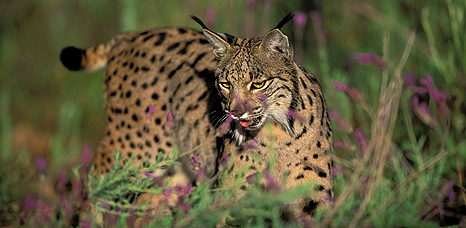Daphne Pleace travelled on our 'Spain - Realm of the Iberian Lynx' holiday and submitted this entry to our writing competition.
Iberian Lynx by Herminio Muniz
'Being Stared at Long & Hard' by Daphne Pleace
Being stared at long and hard by a full-grown male Lynx only feet away is disconcerting. Even from the safety of a vehicle, and even knowing they don’t attack homo sapiens, the experience was heart-stoppingly exciting. And when he dismisses us, for all his proximity and size, this fabulous creature simply vanishes into the scrub, with not even a trademark ear tuft showing. Some of us in the van just stare at each other, wide eyed. Did we really experience that?
Yes we did, and wonderful as it was, there are many more amazing wildlife experiences to come as we make further excursions into Andalucía’s Coto Doñana National Park.
El Rocío, home for two nights, is definitely not just another little Andalusian village. There are more locals on horseback – often bareback - than in cars, dust roads, clouds of Spotless Starlings (with spots – how can a body learn this stuff?); and our lovely hotel situated on the very edge of la Madre de las Marismas – mother of all swamps.
Wetland wonderland is a less accurate translation, but a more accurate description of this magical, wild area. I need only look out of my bedroom window to see several species, and huge numbers, of water birds, including Egrets little and large; flocks of Greater Flamingo; Glossy Ibis … all standard fare, apparently, but for someone who only knows British wildlife, many are first ever sightings for me. Plenty of mammals too: Red Deer on the far bank, wild horses in the shallows, a vole running over my foot as I stand rooted to the spot. I am starring in, not just watching, a wildlife documentary.
In the next few days, I have many more treats: no rare species or giant beasties, but for this inexperienced wildlife traveller, I have a ball.
We see Wild Boar a few times in the woods and scrub but the young one, pottering along on his own on the side of the road as we drive slowly past, brings a smile to my face. As does encountering my first Hoopoe and Azure-winged Magpie. ‘Ordinary’ European birds, I know, but how extra-ordinary.
The highlight for many on this kind of holiday is the number and range of birds of prey. We see more than a dozen out of 20 possibles on the all-season tour list, but my eyesight is poor, and I have low expectations of seeing such creatures, or at best seeing them as distant specks. But someone at Naturetrek has clearly rung ahead to the pair of Spanish Imperials who sit, imperially, for almost an hour in a tree close enough to give me good views through my own bins, and stunning ones through someone’s scope. I retract what I said about not seeing any ‘giant beasties’!
We see the eagle pair whilst we’re in the Sierra Morena and scanning for the Lynx we can hear calling, but can’t see. The longer stay in one place is a great opportunity for me to hone my skills in scanning for some of my ‘own’ birds and mammals, and to wander off a little and simply feel my way into this vast, open landscape.
I understand the need, on a wildlife holiday, to ‘target’ species, and get the ticks, but I do enjoy it when we stay a little longer in one place, and have some quiet time absorbing the ambient sounds and smells, waiting to see whatever reveals itself.
This happens again when we visit the beautiful, ever-changing Río de Jándula. I can’t remember what our ‘target’ is, but I enjoy the sounds of water and woodland birds calling. I enjoy watching the sinuous movements of the river, and the splashes of fish, but I’m intrigued most of all by the way that our guide stands, silent and motionless on the bank, clearly on full alert. I notice him raise his head and flare his nostrils, although when I ask him later if he was smelling for anything, he says not.
We easily forget that our layer of ‘civilisation’ is thin, and we use our sense of smell more than we think we do, albeit unconsciously. My experience of wildlife guides is that as ‘hunters’ they can operate on the same animal level as their ‘prey’ (as well as using their extensive intellectual knowledge), and the best ones can access that atavistic element.
However he did it, he was the first of us to spot the Otter, only her sleek head showing, swimming silently in the semi-darkness behind a wall of tree roots growing out of the bank into the river. She appeared to be trapped in a cage. We watched her, watching us, for some moments before she too, like the Lynx, disappeared without trace.
Read more about our'Spain - Realm of the Iberian Lynx' holiday.



 Loading search...
Loading search...
